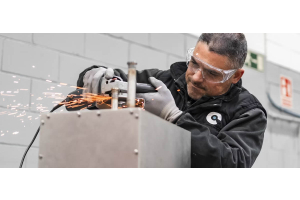
New Safety Standards were established in 2022 which will change the tests to be done and complied with to meet the new European Standards
1. Perforation Resistance – Classifications differentiating perforating nail size - NEW
2. Slip Resistance – has a separate rating that must be stated, referenced as SR
3. Water Resistance: Whole Shoe
4. Water Resistance: Raw Materials – Upper only
5. Resistance to Fuel Oil – must be stated, referenced as FO
6. Scuff Caps Abrasion Resistance - NEW
7. Ladder Grips – NEW
PERFORATION RESISTANCE - NEW
For Steel midsoles, ONLY the 4.5mm nail will be used. Compliant footwear would thus be classified as previous standard – i.e. S1P / S3 etc.
For Metal free midsoles, either the Large or Small nail can be used, and dependent upon test standards achieved would be classified as follows:
S1PL : Metal Free midsole with 4.5mm nail penetration resistance
S1PS : Metal Free midsole with 3.0mm nail penetration resistance
S3L : Metal Free midsole with 4.5mm nail penetration resistance
S3S : Metal Free midsole with 3.0mm nail penetration resistance
SLIP RESISTANCE




EN ISO 20345:2011 employs a method with the shoe sole / heel placed at a 7-degree angle to the floor. Downward and forward force are then applied to simulate sole slip, and resistance is measured.




EN ISO 20345:2011 Also employs a method with the shoe flat on the floor. Downward and forward force are then applied to simulate sole slip, and resistance is measured.
This part of the method will be withdrawn within 2 years following the publication of the EN ISO




EN ISO 20345:2022 will employ a new method with the shoe tilted at a 7-degree angle at the forefoot. Downward and backward force are then applied to simulate sole slip, and resistance is measured as the shoe is pushed backwards.
Note: Testing on Steel surfaces using Glycerol will be dropped
WATER RESISTANCE
In EN ISO 20345:2011, footwear marked with S2 or S3 uses WRU (Water Resistant Upper) or water repellent upper materials.
Such construction is not entirely waterproof. The sewing used to construct the upper might allow for water ingress through the sewing holes for example.
Currently waterproof footwear is identified with the symbol WR, and likely uses other technology, such as a breathable membrane, or it might have tape-sealed seams or special adhesives to block water ingress and vital areas of the upper.
What changes?
In EN ISO 20345:2022 there will be two additional categories for footwear identifying shoes made with uppers which are waterproof (WR) as whole shoes. These product types will carry the new symbols, S6 or S7.
S6: Relates to waterproof footwear without the anti-perforation midsole – Currently such product would be referred to as S2 (WR)
S7: Relates to waterproof footwear with the anti-perforation midsole – Currently such product would be referred to as S3 (WR)
WATER RESISTANCE – Raw upper materials
In EN ISO 20345 (Overlying standard) Footwear made with a water-resistant upper is marked as WRU
In EN ISO 20345:2011 the name was modified to Water Penetration and Absorption resistance but retained the same WRU symbol.
In EN ISO 20345:2022 such footwear – i.e. with water-resistant raw upper materials, there is a requirement to identify the product with the acronym WPA
RESISTANCE TO FUEL OIL/HYDROCARBONS
Requirement: A Fuel Oil Resistant sole which comes into contact with hydrocarbons must not expand to more than 12% of its original volume.
In EN ISO 20345:2022 If footwear made satisfies the additional FO requirement, this isn’t included in the S1 (S2 & S3) and is indicated separately.
This means that under EN ISO 20345:2022 an S1 shoe with Fuel Oil Resistance would need to be classified as S1 FO for example.


SCUFF CAPS ABRASION RESISTANCE - NEW
A new requirement in the EN ISO 20345:2022 standard
Viable footwear, including a Scuff Cap can be marked the new SC acronym.
The standard regulates the type of protection scuff cap, “bumper” or “Stone Guard” and states what is compliant.
Only product with a specific resistance to abrasion may carry the SC marking.
The standard allows for distinction between aesthetic caps and those actually guaranteed to
a minimal abrasion resistance.
The standard requires >8,000 abrasion cycles without the appearance of a hole in the scuff cap.
LADDER GRIPS - NEW
Another new additional requirement in EN ISO 20345:2022
Footwear boasting the addition of a Ladder Grip must comply with the following regulations:
The sole and heel must be defined from each other, with a “waist” area in the arch of the foot.
The waist area must be a minimum of 35mm.
The heel breast (leading edge of the heel) must be at least 10mm in height and at a specific angle anywhere between 90 and 120 degrees.
Ladder grips must include a cleated design on the waist area with transverse cleats with a height of >1.5mm.
Footwear compliant with this standard can be marked as LG





